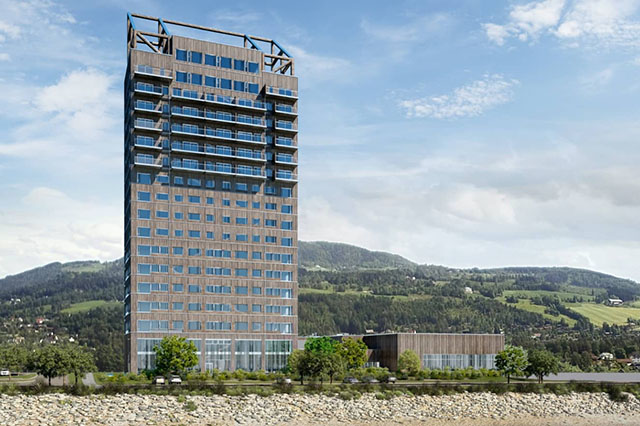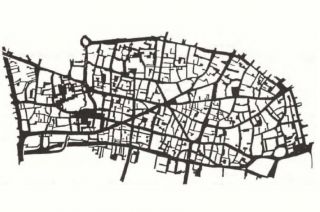
www.buildingsandcities.org/insights/commentaries/embodied-carbon.html
Embodied Carbon: Breaking Construction Dependencies

Viable alternatives exist to reduce the use of concrete in construction.
Does concrete have to be used widely? Given the large amounts of GHGs generated by concrete, what alternative materials and design optimisations exist? Ronita Bardhan (University of Cambridge) and Ramit Debnath (University of Cambridge) discuss some options for how we can immediately reduce concrete consumption.
The global building sector accounted for nearly 37% of the global carbon dioxide (CO2) emissions in 2020: building operations are responsible for 27% annually and building materials / construction processes (typically referred to as embodied carbon) are responsible for an additional 10% annually (UNEP 2021). Concrete is a primary contributor of embodied carbon emissions, accounting for 8% of global CO2 emissions. According to Intergovernmental Panel on Climate Change (IPCC), the global warming must be restricted to 1.5 °C by radically reducing GHG emissions. This means the CO2 emissions has to peak within a short time-window i.e., before 2030 and fall to net zero by around 2050. Thus, the urgent need to include embodied emissions (Fankhauser et al. 2022).
The challenges to reaching net-zero and resilient buildings and the construction sector are considerable, especially as 82% of the predicted population growth added by 2030 is in countries without any specific building emission reduction targets (UNEP 2021). In addition to radically reducing emissions from building operation, emissions from materials and construction processes must be urgently addressed to ensure that today's buildings are optimised for low-carbon solutions across the entire life cycle.
Comprehensive and sustainable solutions are needed. Replacing concrete from the construction and building sector requires a system-wide strategy. This involves evaluating each design choice using a whole lifecycle approach and seeking to minimise upfront carbon impacts (e.g. lean construction, low-carbon materials and construction processes, etc.), maximising the refurbishment of existing buildings and taking steps to avoid future embodied carbon during and at the end of life (Lützkendorf & Frischknecht 2020).
Materials to minimise upfront carbon impact
Bamboo is a versatile building material that is also rapidly renewable. Bamboo can be used in both pole construction (as scaffolding, roofing, framing elements, etc) and manufactured products (as engineered structural components, finishes, and acoustic and structural panels). Bamboo offers superior mechanical properties, tensile strength, elasticity, and cost-effectiveness as a building material. It has greater compressive strength than concrete and almost the same strength-to-weight ratio as steel in tension (Li et al. 2020) and a higher tensile strength than steel (Kathiravan et al. 2021), making it a low-carbon alternative to steel bars or structural steel members. Engineered bamboo structural components such as bamboo nail laminated timber systems have high elasticity, making them suitable for use in extreme wind and earthquake conditions. Bamboo is also fire resistant due to its high silica content.
Bamboo forests sequester carbon like timber forests; however, carbon sequestration varies significantly across 1600 bamboo species. The species predominantly used in building materials is the Moso bamboo that can sequester about 102-289 t/C per hectare annually in the forest ecosystem where it is grown. A unique characteristic of bamboo plants is that it does not die after harvesting, thereby avoiding any deforestation. For enabling bamboo as a carbon smart material in the current construction and building sector, policy support is needed to establish a robust supply chain of only specific bamboo species (e.g. Moso) in sustainably managed bamboo forests. Policy and strategy can ensure specification of bamboo products that come from sustainability managed forests and not created through land-use change like clearing natural timber forests for bamboo plantations (Xu et al. 2018). Moreover, sourcing bamboo products locally can reduce transportation emissions and specification can also avoid fossil fuel emissions during the manufacture of engineered bamboo components.
Hempcrete is another low-carbon material for building structural applications. It is a monolithic wall system that consists of hemp hurd (the inner woody core of the hemp plant, also called shiv), lime, and a hydraulic additive over structural support. Industrial hemp absorbs 8 - 15 t/CO2 per hectare of cultivation, capturing atmospheric carbon twice as effectively as forests while providing carbon-negative biomaterials for the built environment (Ahmed et al. 2022). Hemp demands little water to grow and therefore can have high drought resilience. It grows approximately 50 times faster than a tree, allowing it to be rapidly cultivated for industrial applications.
Hempcrete wall systems have high thermal performance owing to their high thermal mass and insulation property (R-value: 0.67/cm to 1.2/cm). It transmits humidity, is fireproof, deters insects and rodents, resists mould and has excellent acoustic performance. It is also recyclable, does not emit volatile organic compounds (VOC) or other toxins, and can endure for centuries.
Timber from managed forestry also stores carbon instead of emitting it. As a rule of thumb, a cubic metre of wood contains around a tonne of CO2 (depending on the tree species). When used as structural timber (also known as mass timber), the wood provides promise for a low carbon built environment at scale (Churkina et al. 2020). Mass timber is a generic term that encompasses products of various sizes and functions, like glued-laminated (glulam) beams, laminated veneer lumber (LVL), nail-laminated timber (NLT), dowel-laminated timber (DLT) and cross-laminated timber (CLT). Apart from emission reduction in the building and construction sector, mass timber buildings offer additional benefits: better fire performance, faster construction with less waste and better earthquake performance compared with concrete structures. Additionally, it is aesthetically pleasing and can generate rural livelihood.
Concrete 2.0: less than 'concrete'
Around 79% of concrete's CO2 emissions come from the cement even though it only represents 13% of the material. It is estimated that around 1 tonne of CO2 is emitted in producing per ton of clinker. The International Energy Agency (IEA 2021) estimates that the ways to reduce these emissions are (i) improving the energy efficiency of the cement production processes by using alternative fuels and/or biomass, (ii) promoting material efficiency by reducing the clinker-to-cement ratio, and (iii) by advancing process and technology innovations for replacing cement with complementary cementing materials (CCM) and lastly iv) carbon capture and storage. This new generation of concrete produced is often termed Concrete 2.0 or 'green' cement, a more sustainable alternative to the traditional one. However, greening the cement industry will need significant effort and investment to implement this. A critical factor is the replacement costs of traditional cement production facilities particularly issues surrounding their sunk costs. Current knowledge remains blurred on where and how the Cement 2.0 is resourced, produced and distributed. There is also lack of information on the net-zero fuel mix required to completely decarbonise the cement industry.
The promise of Concrete 2.0 is to reduce the carbon content: alternatives to Portland cement are based on different chemical compositions (e.g. alternatives to clinker: pozzolans, the Third Cement Series or recycled concrete) but there are consequences for structural performance and cost. Approximately 26% of Britain's concrete is already manufactured using recycled concrete.
However, the real challenge is in the developing world, which is yet to build two-thirds of its required building stock. The carbon emissions from the cement industry have increased by 186% between 1990 and 2019. The majority of this growth is witnessed in developing countries in Asia, the Middle East and Africa, where new infrastructure is being built (Chen, et al. 2020). The study suggested an annual growth rate between 20-40% in China, India and sub-Saharan Africa.
Material replacement and design optimisation
Design optimisation of concrete elements can reduce the amount of concrete used and the resulting embodied emissions. Optimally shaped horizontal spanning elements, such as floor beams and slabs, can reduce 80% of the structural mass and massive trapped embodied energy without compromising the strength (Ismail et al. 2021). The trade-offs between operational and embodied carbon need to be considered together over the life cycle. In some situations, it may be advisable to use a material with high embodied carbon if it reduces operational carbon emissions and results in substantially lower overall emissions. This calculation is far from easy, as it also introduces the question of time - when it is most advantageous to reduce emissions. Suitable policy frameworks that can provide clarity to designers, specifiers and manufacturers would provide more confidence in innovative materials and technology and help to decarbonise future growth.
Conclusions
A rapid transition is needed to reduce GHG emissions from the building stock: both embodied and operational emissions. Viable alternatives to concrete exist that can used today in many situations by engineers, specifiers and contractors. Solutions require a holistic understanding of the impacts of specified materials.
Governments must broaden their regulations to include embodied GHGs within the regulatory framework for buildings. A life-cycle analysis approach is recommended that combines operational and embodied GHGs.
Construction professionals have a duty of care to use and promote materials with low embodied carbon. The research community can assist with this by providing solutions involving alternative materials. In-depth research is needed to catalogue the benefits and co-benefits of alternative materials and provide clear methods for carbon accounting (Hoxha et al. 2020). A systems approach is needed to understand the impacts of concrete and the choice for alternative material while equalising the distributive impacts.
References
Ahmed, A. T. M. F., Islam, M. Z., Mahmud, M. S., Sarker, M. E. & Islam, M. R. (2022). Hemp as a potential raw material toward a sustainable world: A review. Heliyon, 8, e08753.
Chen, C., Xu, R., Tong, D., Qin, X., Cheng, J., Liu J., Zheng, B., Yan, L. & Zhang, Q. (2022). A striking growth of CO2 emissions from the global cement industry driven by new facilities in emerging countries. Environmental Research Letters, 17, 044007 (2022).
Churkina, G., Organschi, A., Reyer, C.P.O., Ruff, A., Vinke, K., Liu, Z., Reck, B.K., Graedel, T.E. & Schellnhuber, H.J. (2020). Buildings as a global carbon sink. Nature. Sustainability, 3, 269-276.
Fankhauser, S., Smith, S.M., Allen, M. et al. (2022). The meaning of net zero and how to get it right. Nature Climate Change, 12, 15-21. https://doi.org/10.1038/s41558-021-01245-w
Lützkendorf, T., & Frischknecht, R. (2020). (Net-) zero-emission buildings: a typology of terms and definitions. Buildings and Cities, 1, 662-675. DOI: http://doi.org/10.5334/bc.66
Hoxha, E., Passer, A., Saade, M. R. M., Trigaux, D., Shuttleworth, A., Pittau, F., Allacker, K. & Habert, G. (2020). Biogenic carbon in buildings: a critical overview of LCA methods. Buildings and Cities, 1, 504-524. DOI: http://doi.org/10.5334/bc.46
IEA. (2021). Cement. International Energy Agency. https://www.iea.org/reports/cement
Ismail, M. A., Mayencourt, P. L. & Mueller, C. T. (2021). Shaped beams: unlocking new geometry for efficient structures. Architecture, Structures and Construction, 1, 37-52.
Kathiravan, N. S., Manojkumar, R., Jayakumar, P., Kumaraguru, J. & Jayanthi, V. (2021). State of art of review on bamboo reinforced concrete. Materials Today Proceedings, 45, 1063-1066.
Li, Z., Chen, C., Mi, R., Gan, W. Dai, J., Jiao, M., Xie, H. Yao, Y. Xiao, S. & Hu, L. (2020). A strong, tough, and scalable structural material from fast‐growing bamboo. Advanced Materials, 32, 1906308.
UKGBC. (2019). Net zero carbon buildings: a framework definition. London: UK Green Building Council.
UNEP. (2021). Global status report for buildings and construction: towards a zero‑emission, efficient and resilient buildings and construction sector. Nairobi: United Nations Environment Programme.
Xu, M., Ji, H. & Zhuang, S. (2018). Carbon stock of Moso bamboo (Phyllostachys pubescens) forests along a latitude gradient in the subtropical region of China. PLOS ONE 13(2): e0193024.
Latest Peer-Reviewed Journal Content
Acceptability of sufficiency consumption policies by Finnish households
E Nuorivaara & S Ahvenharju
Key factors for revitalising heritage buildings through adaptive reuse
É Savoie, J P Sapinski & A-M Laroche
Cooler streets for a cycleable city: assessing policy alignment
C Tang & J Bush
Understanding the embodied carbon credentials of modern methods of construction
R O'Hegarty, A McCarthy, J O'Hagan, T Thanapornpakornsin, S Raffoul & O Kinnane
The changing typology of urban apartment buildings in Aurinkolahti
S Meriläinen & A Tervo
Embodied climate impacts in urban development: a neighbourhood case study
S Sjökvist, N Francart, M Balouktsi & H Birgisdottir
Environmental effects of urban wind energy harvesting: a review
I Tsionas, M laguno-Munitxa & A Stephan
Office environment and employee differences by company health management certification
S Arata, M Sugiuchi, T Ikaga, Y Shiraishi, T Hayashi, S Ando & S Kawakubo
Spatiotemporal evaluation of embodied carbon in urban residential development
I Talvitie, A Amiri & S Junnila
Energy sufficiency in buildings and cities: current research, future directions [editorial]
M Sahakian, T Fawcett & S Darby
Sufficiency, consumption patterns and limits: a survey of French households
J Bouillet & C Grandclément
Health inequalities and indoor environments: research challenges and priorities [editorial]
M Ucci & A Mavrogianni
Operationalising energy sufficiency for low-carbon built environments in urbanising India
A B Lall & G Sethi
Promoting practices of sufficiency: reprogramming resource-intensive material arrangements
T H Christensen, L K Aagaard, A K Juvik, C Samson & K Gram-Hanssen
Culture change in the UK construction industry: an anthropological perspective
I Tellam
Are people willing to share living space? Household preferences in Finland
E Ruokamo, E Kylkilahti, M Lettenmeier & A Toppinen
Towards urban LCA: examining densification alternatives for a residential neighbourhood
M Moisio, E Salmio, T Kaasalainen, S Huuhka, A Räsänen, J Lahdensivu, M Leppänen & P Kuula
A population-level framework to estimate unequal exposure to indoor heat and air pollution
R Cole, C H Simpson, L Ferguson, P Symonds, J Taylor, C Heaviside, P Murage, H L Macintyre, S Hajat, A Mavrogianni & M Davies
Finnish glazed balconies: residents' experience, wellbeing and use
L Jegard, R Castaño-Rosa, S Kilpeläinen & S Pelsmakers
Modelling Nigerian residential dwellings: bottom-up approach and scenario analysis
C C Nwagwu, S Akin & E G Hertwich
Mapping municipal land policies: applications of flexible zoning for densification
V Götze, J-D Gerber & M Jehling
Energy sufficiency and recognition justice: a study of household consumption
A Guilbert
Linking housing, socio-demographic, environmental and mental health data at scale
P Symonds, C H Simpson, G Petrou, L Ferguson, A Mavrogianni & M Davies
Measuring health inequities due to housing characteristics
K Govertsen & M Kane
Provide or prevent? Exploring sufficiency imaginaries within Danish systems of provision
L K Aagaard & T H Christensen
Imagining sufficiency through collective changes as satisfiers
O Moynat & M Sahakian
US urban land-use reform: a strategy for energy sufficiency
Z M Subin, J Lombardi, R Muralidharan, J Korn, J Malik, T Pullen, M Wei & T Hong
Mapping supply chains for energy retrofit
F Wade & Y Han
Operationalising building-related energy sufficiency measures in SMEs
I Fouiteh, J D Cabrera Santelices, A Susini & M K Patel
Promoting neighbourhood sharing: infrastructures of convenience and community
A Huber, H Heinrichs & M Jaeger-Erben
New insights into thermal comfort sufficiency in dwellings
G van Moeseke, D de Grave, A Anciaux, J Sobczak & G Wallenborn
'Rightsize': a housing design game for spatial and energy sufficiency
P Graham, P Nourian, E Warwick & M Gath-Morad
Implementing housing policies for a sufficient lifestyle
M Bagheri, L Roth, L Siebke, C Rohde & H-J Linke
The jobs of climate adaptation
T Denham, L Rickards & O Ajulo
Structural barriers to sufficiency: the contribution of research on elites
M Koch, K Emilsson, J Lee & H Johansson
Disrupting the imaginaries of urban action to deliver just adaptation [editorial]
V Castán-Broto, M Olazabal & G Ziervogel
Nature for resilience reconfigured: global- to-local translation of frames in Africa
K Rochell, H Bulkeley & H Runhaar
How hegemonic discourses of sustainability influence urban climate action
V Castán Broto, L Westman & P Huang
Fabric first: is it still the right approach?
N Eyre, T Fawcett, M Topouzi, G Killip, T Oreszczyn, K Jenkinson & J Rosenow
Social value of the built environment [editorial]
F Samuel & K Watson
Understanding demolition [editorial]
S Huuhka
Data politics in the built environment [editorial]
A Karvonen & T Hargreaves



Latest Commentaries
Decolonising Cities: The Role of Street Naming
During colonialisation, street names were drawn from historical and societal contexts of the colonisers. Street nomenclature deployed by colonial administrators has a role in legitimising historical narratives and decentring local languages, cultures and heritage. Buyana Kareem examines street renaming as an important element of decolonisation.
Integrating Nature into Cities
Increasing vegetation and green and blue spaces in cities can support both climate change mitigation and adaptation goals, while also enhancing biodiversity and ecological health. Maibritt Pedersen Zari (Auckland University of Technology) explains why nature-based solutions (NbS) must be a vital part of urban planning and design.